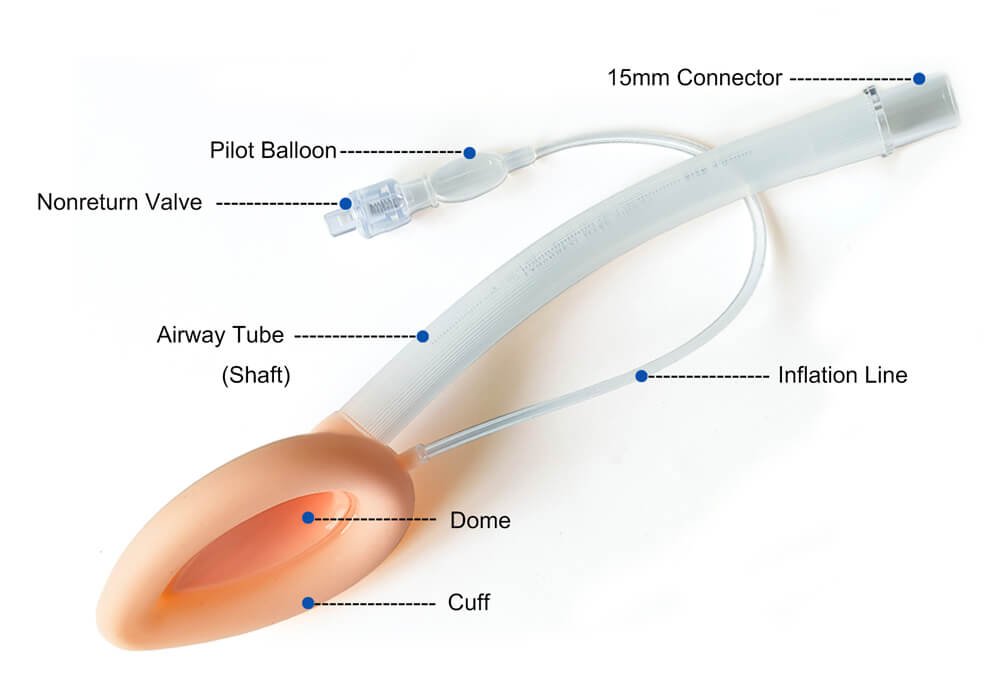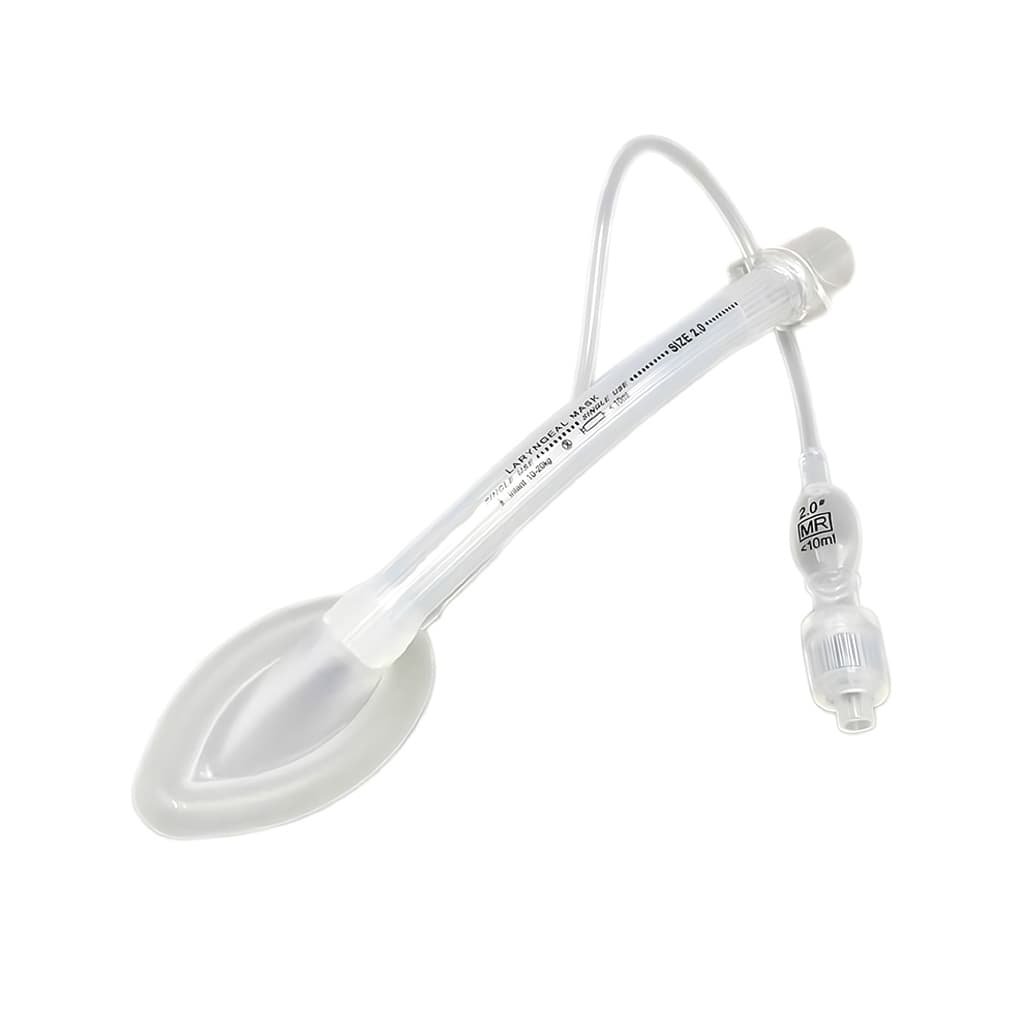The laryngeal mask airway(LMA) is a medical consumable widely used in Respiratory departments, Anaesthesiology departments,Pre-hospital emergency, and Ambulance Vehicles.
Prior to the procedure, it is important for the surgeon to have a thorough knowledge of the product’s indications, function, sizing and maintenance to ensure safe and effective use of them.

What is a Laryngeal Mask Airway (LMA)?
A laryngeal mask is a supraglottic airway (SGA) device that is inserted into the pharynx and then forms a seal around the larynx for ventilation, oxygenation and administration of anaesthetic gases without the need for endotracheal tube.
History and Evolution of Laryngeal Mask
- Invented in 1981 by British anaesthetist Dr. Archie Brain.
- Batch manufactured by Bivona in India in 1987.
Launched in the UK in 1988
Classified as a first-generation general laryngeal mask: sealing pressure 20 cmH2O, no drain tube to the oesophagus.
Indications: body surgery, e.g. hernia repair surgery, limb surgery, paediatric surgery, surgery to preserve spontaneous breathing
- 1991 FDA approved as an alternative to face masks
1993 Reinforced Laryngeal Maks Airway (RLMA) introduced
Classified as a first-generation general mask: sealing pressure of 20 cmH2O, no drain to the oesophagus, bendable main tube.
Indications: oral extractions, endonasal surgery, medical imaging, radiotherapy, interventional radiotherapy, paediatric surgery, etc.
1997 Intubating laryngeal mask introduced
Classified as a second generation mask.It is more suitable for blind tracheal intubation or intubation under fibreoptic microscope guidance, and is an excellent access for ventilation and endotracheal intubation.
1998 Disposable laryngeal masks were introduced
In order to meet the needs of emergency rooms, ambulances, battlefield ambulances, and patients with special infections, disposable laryngeal masks made of medical PVC began to appear on the market. This material is not autoclavable.
Reusable double-lumen laryngeal mask introduced in 2000
Classified as the third generation of reusable laryngeal masks: sealing pressure >30cmH2O, with drainage to the oesophagus, 14F drainage tube can be placed and can be used repeatedly.
The double-lumen type laryngeal mask has high positive-pressure respiratory airtightness and prevents gastric contents from refluxing and misaspiration, so it can be adapted to abdominal surgery, overcoming the shortcomings of the first-generation laryngeal mask.
Indications: laparoscopic gallbladder surgery, laparoscopic gynaecological surgery, laparoscopic urological surgery (supine and lateral position), open lower abdominal surgery, obstetrics surgery, limb surgery, and fiberscope examination.
Single-use double lumen laryngeal mask introduced in 2007
Classified as a third-generation disposable double-lumen laryngeal mask, with sealing pressure >24-25cmH2O and a drain to the oesophagus: 14F drain can be placed
Indications: laparoscopic gallbladder surgery, laparoscopic gynaecological surgery, laparoscopic urological surgery (supine and lateral position), open lower abdominal surgery, obstetric surgery, limb surgery, etc.
Non-inflatable laryngeal mask introduced in 2007
Classified as the third generation reusable mask: airway sealing pressure of 30cmH2O, oesophageal sealing pressure of 13cmH2O, drainage tube to the oesophagus: 12F drainage tube can be placed, non-inflatable condom, disposable use
Indications: laparoscopic gallbladder / gynaecological / urological surgery, open lower abdominal surgery, obstetrics surgery, limb surgery, fibroscopy.
In 2014, in order to improve the shortcomings of intubating laryngeal mask, such as arytenoid cartilage damage, accidental entry into the oesophagus, and the need for fiberscope guidance, the visual intubating laryngeal mask was invented and promoted for use.
Main usages of the Laryngeal Mask
- Initial airway management: Primary care in cases of neck/face/chest trauma or airway oedema, to ensure an open airway and oxygenation if necessary.
- Rescue ventilation when mask ventilation is difficult.
- Can be used as an access point for tracheal intubation.
What are the Indications for Inserting a Laryngeal Mask?
Application in unanticipated difficult airways. The laryngeal mask airway should be preferred after induction of anaesthesia when intubation is found to be difficult, especially in emergency situations where neither intubation nor ventilation by mask is possible.
- Short procedures or extremity surgery requiring a laryngeal mask can be performed directly under preserved spontaneous breathing or IPPV.
- Endotracheal intubation can be performed through the laryngeal mask.
- After the patient is awake, blind endotracheal intubation is performed under surface anaesthesia and sedation using either fibrinoscope-guided endotracheal intubation or transnasally.
- Patients with cervical instability, head and neck surgery and ophthalmic surgery
- Patients with cardiovascular disease with little cardiovascular impact.
- Respiratory medicine and thoracic surgery:
Under surface anaesthesia with sedation or general anaesthesia, a laryngeal mask is inserted and spontaneous breathing is preserved. The following operations are performed with intravenous or inhalation anaesthesia maintenance:
- Fibreoptic laryngoscopy and fibreoptic bronchoscopy through a laryngeal mask
- Laser resection of endotracheal and supratracheal tumours through the laryngeal mask
- Placement of tracheal and bronchial extenders through a laryngeal mask
- Percutaneous tracheostomy in the ICU, guided by fibreoptic bronchoscopy.
- Anaesthesia outside the operating theatre: Admit and children for minor therapeutic or diagnostic operations outside the operating theatre.
- Prompt establishment of artificial ventilation during emergency airway management or cardiopulmonary resuscitation.
- MRI in critically ill patients
Laryngeal Mask Sizing and Selection
Getting the right fit can make all the difference in ensuring proper ventilation and a comfortable experience for the patient. The following are the general parameters of the laryngeal mask.
| Size | 1.0# | 1.5# | 2.0# | 2.5# | 3.0# | 4.0# | 5.0# |
|---|---|---|---|---|---|---|---|
| Patient Weight | <5kg | 5-10kg | 10-20kg | 20-30kg | 30-50kg | 50-70kg | 70-100kg |
| Cuff Volume | <4ml | <7ml | <10ml | <14ml | <20ml | <30ml | <40ml |
| Package | 100pcs/ctn | 100pcs/ctn | 100pcs/ctn | 100pcs/ctn | 100pcs/ctn | 100pcs/ctn | 100pcs/ctn |
The End
By adopting the insights and recommendations in this guide, healthcare providers can become proficient in the expertise and essentials of laryngeal masks and provide safe airway management products in a variety of medical procedures.
Our laryngeal masks are CE (MDR) certified and we are a professional manufacturer, with all our products passing stringent testing and validation. These products are exported all over the world and are appreciated for their high quality.

